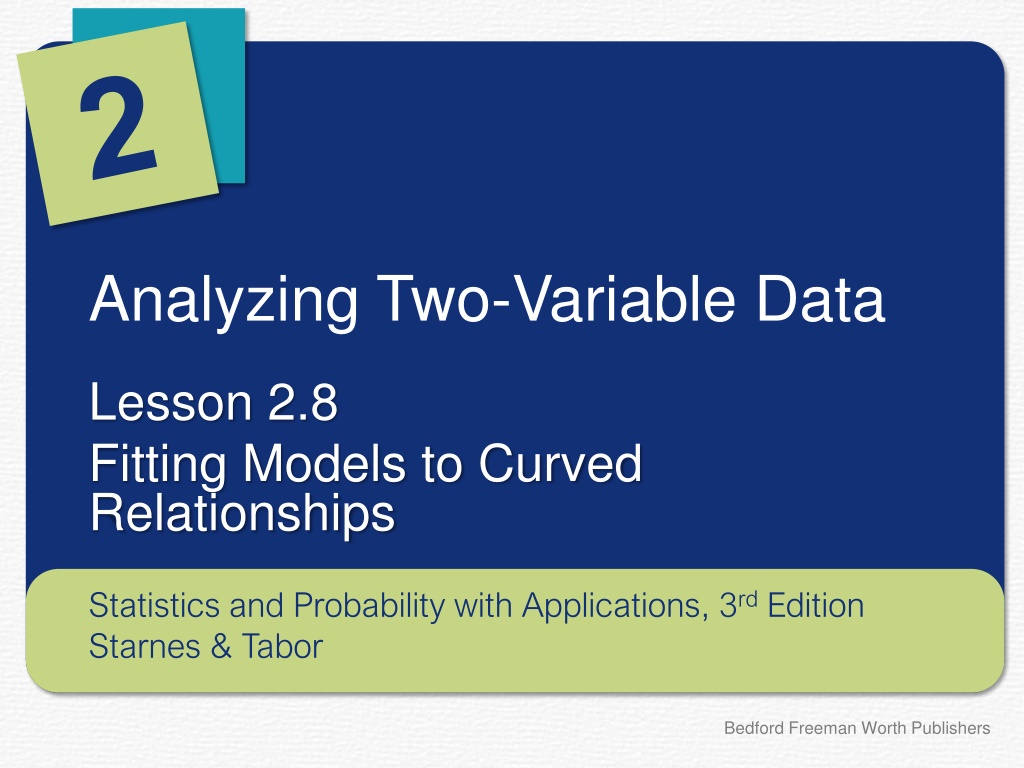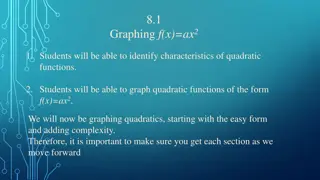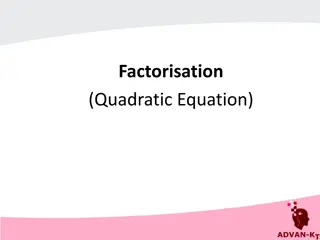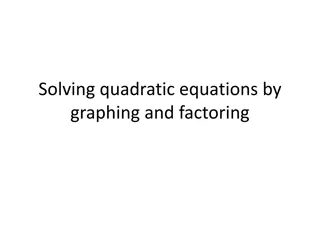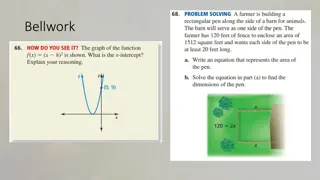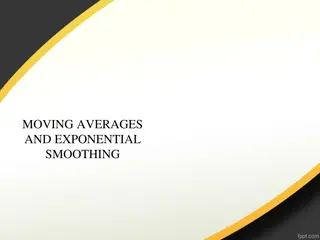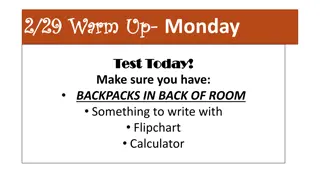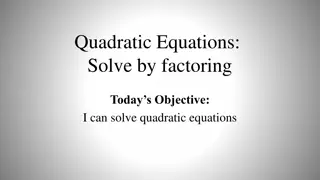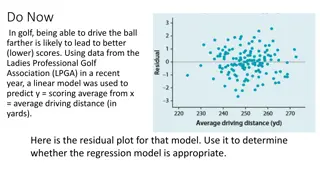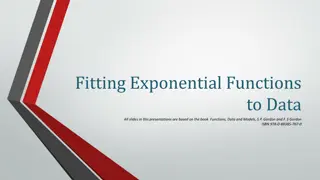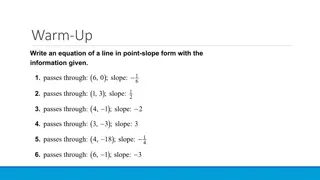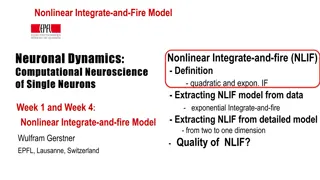Understanding Quadratic and Exponential Models for Curved Relationships
Explore fitting models to curved relationships in statistics, using quadratic and exponential models to analyze two-variable data. Learn how to calculate, interpret residuals, and determine the most appropriate model through residual plots. Discover applications in various fields, such as sports statistics like pitching performance in baseball.
Download Presentation

Please find below an Image/Link to download the presentation.
The content on the website is provided AS IS for your information and personal use only. It may not be sold, licensed, or shared on other websites without obtaining consent from the author. Download presentation by click this link. If you encounter any issues during the download, it is possible that the publisher has removed the file from their server.
E N D
Presentation Transcript
Analyzing Two-Variable Data Lesson 2.8 Fitting Models to Curved Relationships Statistics and Probability with Applications, 3rdEdition Starnes & Tabor Bedford Freeman Worth Publishers
Fitting Models to Curved Relationships Learning Targets After this lesson, you should be able to: Use technology to calculate quadratic models for curved relationships, then calculate and interpret residuals using the model. Use technology to calculate exponential models for curved relationships, then calculate and interpret residuals using the model. Use residual plots to determine the most appropriate model. Statistics and Probability with Applications, 3rdEdition 2 2
Fitting Models to Curved Relationships When the association between two quantitative variables is linear, we use a least-squares regression line to model the relationship. When an association is nonlinear, we can use technology to calculate other types of models. In some cases, we can use a quadratic model to fit a nonlinear association between two quantitative variables. Quadratic Model A quadratic model is a model in the form y = ax2 +bx +c . The graph of a quadratic model is a parabola. Statistics and Probability with Applications, 3rdEdition 3 3
Fitting Models to Curved Relationships The scatterplot below shows the relationship between passing yards and age for 32 quarterbacks in the 2010 NFL season. Statistics and Probability with Applications, 3rd Edition 4 4
Fitting Models to Curved Relationships The association between passing yards and age is clearly nonlinear. Passing yards tend to be lower for younger and older quarterbacks and higher for middle-aged quarterbacks. ? = 13.65?2+ 835.5? 9258 Statistics and Probability with Applications, 3rd Edition 5 5
Pitching for WHIP? Pitching for WHIP? Calculating and using a quadratic model Calculating and using a quadratic model Baseball pitchers try to prevent hitters from reaching base. One way to measure the effectiveness of a pitcher is WHIP, which is calculated by the formula: WHIP = for all 17 years of Bob Gibson s MLB hall-of-fame career. PROBLEM: (a) Calculate a quadratic model for these data using age as the explanatory variable. (b) Sketch the scatterplot, along with the quadratic model. (c) Calculate and interpret the residual for observation when Bob was 24 years old. 33 1.102 34 1.190 35 1.185 36 1.129 37 1.108 38 1.417 39 1.670 walks + hits innings pitched. The table shows the age and WHIP Age 23 24 25 26 27 28 29 30 31 32 WHIP 1.533 1.673 1.443 1.151 1.257 1.169 1.157 1.027 1.089 0.853 Statistics and Probability with Applications, 3rd Edition 6 6
Pitching for WHIP? Pitching for WHIP? Calculating and using a quadratic model Calculating and using a quadratic model (a) Calculate a quadratic model for these data using age as the explanatory variable. ? = ?.??? ?.???? + ?.????? (b) Sketch the scatterplot, along with the quadratic model. 27 1.257 28 1.169 29 1.157 30 1.027 31 1.089 32 0.853 33 1.102 34 1.190 35 1.185 36 1.129 37 1.108 38 1.417 39 1.670 Age 23 24 25 26 WHIP 1.533 1.673 1.443 1.151 (c) Calculate and interpret the residual for observation when Bob was 24 years old. ? = ?.??? ?.??? ?? + ?.??? ???= ?.??? ? ? = ?.??? ?.??? = ?.???. Bob s WHIP when he was 24 years old was 0.070 greater than predicted by the quadratic model with x = age. Statistics and Probability with Applications, 3rd Edition 7 7
Fitting Models to Curved Relationships We can also use an exponential model to fit a nonlinear association between two quantitative variables. Exponential Model An exponential model is a model in the form y^ = a(b)x where b > 0. If b > 1, the graph will show exponential growth. If 0 < b < 1, the graph will show exponential decay. Statistics and Probability with Applications, 3rd Edition 8 8
Fitting Models to Curved Relationships Gordon Moore, one of the founders of Intel Corporation, predicted in 1965 that the number of transistors on an integrated circuit chip would double every 18 months. This is Moore s law, one way to measure the revolution in computing. Here is a scatterplot showing the number of transistors for Intel microprocessors and the number of years since 1970. Statistics and Probability with Applications, 3rd Edition 9 9
Does health predict wealth? Does health predict wealth? Calculating and using an exponential model Calculating and using an exponential model Do healthier countries tend to be wealthier countries? A random sample of 20 countries was obtained from gapminder.org. The income per person (US dollars) and life expectancy at birth (years) were recorded. PROBLEM: (a) Calculate an exponential model for these data using life expectancy as the explanatory variable. (b) Sketch the scatterplot, along with the exponential model. (c) Calculate and interpret the residual for Mexico. Lebanon 72.6 13489 Saint Lucia 74.6 10598 Belgium 80.0 33048 Guyana 69.9 4083 Hungary 74.4 17330 China 73.5 8848 Life expectancy (yrs) Country Rwanda Montenegro Germany Mali Afghanistan Lithuania Myanmar Hong Kong, China Nigeria Mexico Samoa Morocco Georgia Benin Income ($) 55.4 74.6 80.4 51.4 48.7 72.2 65.2 82.8 51.9 77.0 72.4 72.2 73.7 56.1 1124 10023 33735 1117 1247 16400 1590 43928 2397 11684 4998 4409 4659 1457 Statistics and Probability with Applications, 3rd Edition 10 10
Does health predict wealth? Does health predict wealth? Calculating and using an exponential model Calculating and using an exponential model (a) Calculate an exponential model for these data using life expectancy as the explanatory variable. ? = ?.???? ?.????? (b) Sketch the scatterplot, along with the exponential model. (c) Calculate and interpret the residual for Mexico. ? = ?.???? ?.??????.?= $????? ? ? = ????? ????? = $???? The annual income per person for Mexico was $2480 less than predicted by the exponential model with x = life expectancy. Statistics and Probability with Applications, 3rd Edition 11 11
Fitting Models to Curved Relationships In some cases, it is hard to tell if a quadratic model or an exponential model would be better to use. To decide, look at the residual plots for both models and choose the model with the residual plot that has the most random scatter. Statistics and Probability with Applications, 3rd Edition 12 12
Black gold in North Dakota? Black gold in North Dakota? Choosing a model Choosing a model PROBLEM: Texas is the state that produces the most oil in the United States, but which state is the second-largest producer? In 2014, North Dakota produced 397 million barrels of oil, making it the second-largest producer of oil in the United States. A scatterplot of the annual oil production (million barrels) versus year (years since 2000) for the state of North Dakota shows a distinct nonlinear relationship. Statistics and Probability with Applications, 3rd Edition 13 13
Black gold in North Dakota? Black gold in North Dakota? Choosing a model Choosing a model An exponential model and a quadratic model were calculated for the relationship between years since 2000 and annual oil production. The residual plots for these models are shown below. Based on the residual plots, which model is more appropriate? Explain. Because the residual plot for the quadratic model seems more randomly scattered, the quadratic model is more appropriate for these data than the exponential model. Statistics and Probability with Applications, 3rd Edition 14 14
LESSON APP 2.8 How does life insurance work? Many adults try to protect their families by buying life insurance. The policyholder makes regular payments (premiums) to the insurance company in return for the coverage. When the insured person dies, a payment is made to designated family members or other beneficiaries. Statistics and Probability with Applications, 3rd Edition 15 15
LESSON APP 2.8 How does life insurance work? How do insurance companies decide how much to charge for life insurance? They rely on a staff of highly trained actuaries people with expertise in probability, statistics, and advanced mathematics to determine premiums. If someone wants to buy life insurance, the premium will depend on the type and amount of the policy as well as on personal characteristics like age, gender, and health status. The table shows monthly premiums (in dollars) for a 10-year term-life insurance policy worth $1,000,000 for people of various ages (in years). Statistics and Probability with Applications, 3rd Edition 16 16
LESSON APP 2.8 How does life insurance work? 1. Calculate a quadratic model for these data. 2. Calculate an exponential model for these data. Statistics and Probability with Applications, 3rd Edition 17 17
LESSON APP 2.8 How does life insurance work? 3. Which model is more appropriate? Justify your answer. 4. Using your chosen model, calculate and interpret the residual for the 65-year-old. Statistics and Probability with Applications, 3rd Edition 18 18
Fitting Models to Curved Relationships Learning Targets After this lesson, you should be able to: Use technology to calculate quadratic models for curved relationships, then calculate and interpret residuals using the model. Use technology to calculate exponential models for curved relationships, then calculate and interpret residuals using the model. Use residual plots to determine the most appropriate model. Statistics and Probability with Applications, 3rd Edition 19 19
